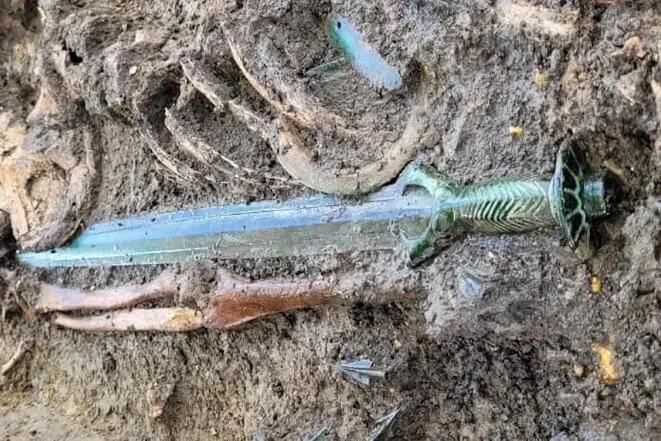By: Kaleena Fraga | All That’s Interesting
Among a collection of Bronze Age burials in Nördlingen, Bavaria, Germany, archaeologists from the Bavarian State Office for the Preservation of Monuments came across an incredible find: a sword with an intricate hilt, so well-preserved that its blade still caught the light.
The blade, found nestled next to the remains of a man, a woman, and a child, may date back to the 14th century B.C.E. and has a rare, octagonal hilt made of bronze. Though greenish today, the hilt would have once shone like a penny.
“The sword and the burial still have to be examined so that our archaeologists can classify this find more precisely,” Mathias Pfeil, head of the Bavarian State Office for the Preservation of Monuments, explained in a statement about the incredible find. “But it can already be said: the condition is exceptional! A find like this is very rare!”
One of the most exceptional things about the sword — which is so well preserved that it “almost still shines” — is its octagonal hilt.
“The production of octagonal swords is complex because the handle is cast over the blade (so-called overlay casting). The decoration is made with an inlay and using hallmarks. While there are two real rivets, another pair of rivets are only implied,” the statement explained.
According to Newsweek, only the most capable Bronze Age blacksmiths could make swords like these (known as Achtkantschwert). Such blacksmiths were known to operate in the north and south of the country, but the sword’s provenance is, for the moment, unknown.
Norimitsu Odachi: This Giant 15th Century Japanese Sword Remains An Enigma!
The sword’s purpose is also unclear. Archaeologists found that the sword had no impact marks, which suggests that it was never used as a weapon. Instead, it could have been used for ceremonial purposes or to indicate its owner’s high status. But the weapon was deadly — it was designed with a centre of gravity that made it suitable for “slashing.”
So who were the people buried alongside this incredible artefact? And did they know each other? Archaeologists aren’t sure yet, though they believe that the man, woman, and child were buried in “quick succession.”
“It is not yet clear whether the persons were related or what the relationship between them was,” their statement explained.
Regardless of the sword’s purpose, or the identity of the people buried alongside it, archaeologists note that it’s incredible to have found it at all. There was widespread looting in this part of Germany during the 19th – century which led the removal of many historical artefacts from similar burial mounds.
“Sword finds from this period are rare and come either from burial mounds that were deliberately opened in the 19th century or as single, presumed sacrificial finds,” the archaeologists’ statement explained.
For now, archaeologists will attempt to learn more about the people in the grave and the sword they were buried with — a Bronze Age weapon so well preserved that it still has some shine, just as it did when it was first wielded some 3,000 years ago.
Let us know your thoughts about this amazıng find below in the comment section.
* * *
NEXT UP!
Joyeuse: The Legendary Sword of Charlemagne
The sword of Joyeuse, which today sits in the Louvre Museum, is one of the most famous swords in history. Historical records link the sword to Charlemagne the Great, King of the Franks.
If it did indeed belong to the famous king, who reigned some 1,200 years ago, the sword of Joyeuse would have been used in countless coronation ceremonies, and is tied with ancient myth and legend ascribing it with magical powers.
The story begins in the year 802 AD. Legend states that the sword of Joyeuse, meaning “joyful” in French, was forged by the famous blacksmith Galas, and took three years to complete. The sword was described as having magical powers associated with it. It was said to have been so bright that it could outshine the sun and blind its wielder’s enemies in battle, and any person who wielded the legendary sword could not be poisoned. The Emperor Charlemagne, coming back from Spain was said to have set up camp in the region and acquired the sword.
* * *
READ MORE: Anunnaki Artefacts That NASA Is Hiding (Video)
Read more on Ancient Artefacts: This Man Underwent Brain Surgery 3,500 Years Ago
Telegram: Stay connected and get the latest updates by following us on Telegram!
We’d love to hear from you! If you have a comment about this article or if you have a tip for a future Collective Spark Story please let us know below in the comment section.

